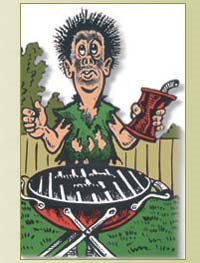As you head out to the grill, it’s important to remember that eating undercooked meat, or foods that have come into contact with raw or undercooked meat, can cause food poisoning (also known as foodborne illness). Symptoms of foodborne illness can include stomach cramps, vomiting, fever and diarrhea. Approximately 1 in 8 people get sick from foodborne illness every year in Canada. Many of these cases could be prevented by following proper food handling and preparation techniques.
You can help lower your risk of foodborne illness by handling and cooking raw meat carefully. Here are some important safety tips to follow:
Storing
•Always store raw meat in a refrigerator or cooler at 4ºC (40ºF) or below.
•If using a cooler, pack it with ice, keep it out of direct sunlight and don’t open it too often.
•Meat packages should be well sealed and placed at the bottom of your refrigerator or cooler so that juices don’t come in contact with other food products.
Cleaning
•Wash your hands, cutting boards, countertops, knives and other utensils thoroughly with soap and warm water before and after handling all raw foods, especially meat.
Grilling
•Colour alone is not a reliable indicator that meat is safe to eat. Use a digital food thermometer to ensure meat has reached a safe internal temperature.
•Check the temperature by inserting the thermometer through the thickest part of the meat.
•When cooking beef hamburgers, remove patties from the grill and insert the thermometer through the side, all the way to the middle.
•When cooking several pieces of meat, check the temperature of each piece.
•Use clean utensils and plates when removing cooked meat from the grill.
•Wash the thermometer in hot, soapy water between every temperature reading (including between every piece of meat).
•Keep food hot until it is ready to serve.
Safe internal cooking temperatures are listed in the chart below:
Food Temperature
Beef, veal and lamb (pieces and whole cuts)
• Medium-rare • 63°C (145°F)
• Medium • 71°C (160°F)
• Well done • 77°C (170°F)
Mechanically tenderized beef or veal (solid cut) • 63°C (145°F)
Steak (turn over at least twice during cooking) • 63°C (145°F)
Pork (pieces and whole cuts) • 71°C (160°F)
Poultry (e.g., chicken, turkey, duck)
• Pieces • 74°C (165°F)
• Whole • 82°C (180°F)
Ground meat and meat mixtures (e.g., burgers, sausages, meatballs, meatloaf, casseroles)
• Beef, veal, lamb and pork • 71°C (160°F)
• Poultry • 74°C (165°F)
•Egg dishes • 74°C (165°F)
•Others: (e.g., hot dogs, leftovers) • 74°C (165°F)



